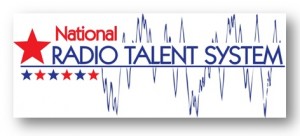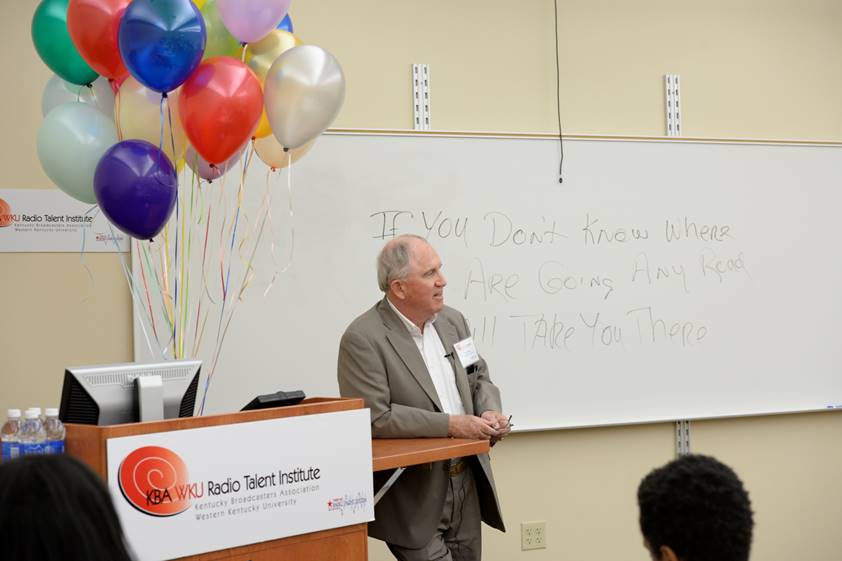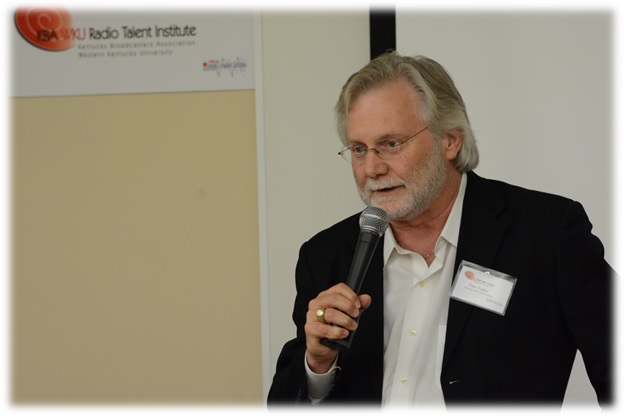“The radio talent pool is really a talent puddle.”
Maybe you’ve said it or heard it before, but it seems like everyone involved with hiring personnel for radio stations has shared this feeling. And then there’s that sense that young people aren’t interested in careers in radio.
Well, myth or fact, it seems that until recently, almost no one has tried to do anything about it.
 That is until Dan Vallie, who many of you know as the guy behind Vallie•Richards•Donovan. So as we start a new year, it seemed appropriate to honor Dan and his commitment to the future of radio in our “Radio’s Most Innovative” series.
That is until Dan Vallie, who many of you know as the guy behind Vallie•Richards•Donovan. So as we start a new year, it seemed appropriate to honor Dan and his commitment to the future of radio in our “Radio’s Most Innovative” series.
Vallie’s organization conducts educational programs called “National Radio Talent Institutes” at affiliate universities across the country, designed to teach young people the craft of radio. Each institute is an intense 10-day program where groups of 25 students attend classes taught by radio professionals. Potential attendees go through an application process designed to identify students that are serious about a broadcasting career.
The program is completely turn-key for the university with Vallie and his team overseeing the application, registration, and creation of the curriculum, along with procuring professional instructors. The costs are offset by a sponsor, which Vallie secures, at each location.
So for this week’s edition of “Radio’s Most Innovative,” we talk to Dan about how this came about. And next week, we’ll look at how the program has impacted both students and the broadcasters who hire them.
JM: What led you to do this in the first place?
DV: I see creating the National Radio Talent System as a noble venture that addresses a need in our industry; helping young people that need that campus-to-career connection to get started in broadcasting.
And it’s a way of giving back. I love the business and the people in it. Radio has been good to me. I’ve been blessed. I couldn’t comprehend when I began as an air talent that I would one day program radio stations and begin Vallie•Richards•Donovan Consulting and work with the best in the business from New York to Los Angeles and all points in between, let alone own a radio station or launch the National Radio Talent System.
And through it all I have been married to a great lady for over 40 years, have a wonderful daughter and son-in-law, and three terrific grandkids.
JM: How did this concept come about?
DV: Actually for me, it goes back to the 1980s when Art Kellar and I talked a lot about needing a farm system for the industry. I worked for Art back then when he owned EZ Communications. Like everyone else, we talked about doing something but other priorities got in the way and the years passed.
Finally, a few years ago I was in the position to be able to take the time to do something about it. I had moved to the Blue Ridge Mountains of North Carolina where Appalachian State University is located and they asked me to be on their advisory board.
Then they asked me to work with their college radio station, teach a mass com activity class and become a Practitioner in Residence. I told them I would if they would support the idea of doing the first Radio Talent Institute. They embraced it wholeheartedly to the point where now it has become a signature program for the university.
To fund it, I called Art Kellar and he didn’t hesitate which is why it’s named the Kellar Radio Talent Institute. It’s our longest running institute and the best example of what can be accomplished through the program.
JM: Is it just for air talent or does it involve all aspects of radio?
DV: It’s for practically every aspect of radio and there are no breakout sessions; every student attends every session regardless of their specific interest.
We help them to realize that it’s important to understand the business side of the business as well. This helps them to further embrace the RAB sales modules that are part of the Institute. Those are taught by a General Manager, Sales Manager or AE in the business and upon completion, students take the RAB exam and are certified as Radio Marketing Professionals.
The same is true of every subject. Production is taught by production directors and national voiceover talent. Inflection, pacing, and communicating are taught by professional air talent. We have news and talk broadcasters, members of sports broadcasting teams and more.
Students also learn the intangibles about succeeding in the industry in sessions like “How to Get In and Win,” “Student to Superstar,” and “Adjusting from College to the Pros.” People who have shared their wisdom included George Beasley of the Beasley Broadcast Group, Dan Mason, president of CBS Radio, Kerby Confer of Forever Communications, Stu Epperson, chairman of Salem Communications, Bud Walters of the Cromwell Group, and others.
JM: Where do the sponsors fit in?
DV: It all begins with the sponsor. While the schools embrace the Institute, most cannot provide financial resources or manpower. The National Radio Talent System does both with funding from broadcasters.
Sponsors can include individual broadcasters, state associations, broadcast groups, organizations or companies. I already mentioned Art Kellar. Kerby Confer sponsors the Institutes in Pennsylvania; the Georgia Association of Broadcasters and the Kentucky Broadcasters Association are the sponsors in their respective states. As we work with more sponsors, we will continue to place more Institutes across America. In fact, we expect to announce two new Institutes in two additional states in the next few weeks.
JM: What challenges did you face launching the program?
DV: Starting any new venture is time consuming, but starting one that has never been done before means you have to think through everything: develop the concept, build a model, create policies and procedures and it’s all without precedent. There is no model to reference, so you have to create everything.
There is also the initial investment. I used my own funds to begin the National Radio Talent System. I believed in it that much. We built the websites, attained the trademarks, bought equipment and everything else we needed so the concept would make sense to potential sponsors and universities.
But it begins with a vision. Many people have ideas, but most don’t have the vision, passion, and determination to turn it into reality. It’s called “work” and it’s harder when it’s never been done before, but it’s a labor of love.
Another challenge is finding people who grasp the vision and become early believers and adopters. In this case, some of those people are Art Kellar and Kerby Confer, Bud Walters, Bob Houghton and his GAB Board, Gary White and the KBA Board, Lisa Reynolds and the NCAB, Whit Adamson of the Tennessee Association of Broadcasters, George Beasley, Steve Newberry, Ed Henson, Christine Hillard, Chuck Anderson and Cox Media, and others.
JM: What is one suggestion you have for stations or companies that want to do a better job of cultivating young talent for radio?
DV: Nurture them when they are hired, whether part-time or full-time or as interns. Make it a priority to spend time with them, teach them, talk to them; make them feel like they are part of something. Make sure they see and hear the positives and the potential, and don’t let them be overly influenced by those who complain or are negative. When we nurture these young people, no matter how green they are, we are nurturing the future of our industry. If they don’t learn from you, who are they going to learn from?
And when we do a Radio Talent Institute in your area, come teach a session. Spend time with the students one-on-one during social hour. I can assure you that you will come away impressed. And if you would like to sponsor a Radio Talent Institute and bring it to your state and region, just give me a call or drop me an email.

JM: What are some other areas of the radio business you believe the industry should be focused on innovating?
DV: The most important one right now is activating the FM chip in cell phones; it’s a game changer. I love and appreciate how Jeff Smulyan has been driving that effort and the support it is getting from the industry. We need to be in smartphones and also in car dashboards and tablets. It has begun with Sprint, but is also moving to other carriers and manufacturers.
We are also innovating in other ways, too, but it’s so subtle and practical ways that it doesn’t get noticed. Innovations in recent years include voice tracking, digital studios, new formats, podcasts, streaming audio enhancements including video, HD Radio, virtual remotes, electronic measurement methodology and the groundwork is being laid, for other exciting things as we move forward.
But even so, what technology does is level the playing field. That is why the most important difference is always people. People are what always has and always will make the difference. That’s why investing in young people we can bring into the business is the most important thing we can do. That’s the reason for the National Radio Talent System.
Next week, Dan will be back talking about youth in radio, and we’ll talk to some of the graduates of the National Radio Institute, as well as one broadcaster who is already reaping the benefits of this innovative program. You can read it here.
If you’d like to connect directly with Dan about how broadcasters and companies can get involved, email him here. More information on the National Radio Talent System is available here.
Thanks to Mike Stern for putting this first “RMI” of the new year together.
INNOVATION QUOTE OF THE WEEK
“Your kids are going to do well in the workplace of the future if they can bring creativity, if they can bring some innovation, if they can bring some entrepreneurialism.”
Dalton McGuinty
Canadian author & former Premier of Ontario
More of Radio’s Most Innovative
- Radio’s Most Innovative: NPR One
- Radio’s Most Innovative: Galaxy Communications’ Ed Levine
- Radio's Most Innovative: Innovate This
- Radio’s Most Innovative: “Sexually Speaking” with Dr. Ruth Westheimer
- Radio’s Most Innovative: XAPPmedia
- Media And Technology In 2025: Believe It Or Not! - April 18, 2025
- In Radio, You Just Never Know - April 17, 2025
- The Secret To Making A Great Podcast (And Great Radio) - April 16, 2025






Leave a Reply